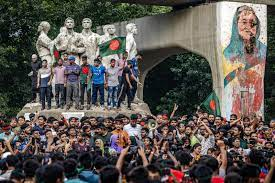
Table of Contents
The India-Bangladesh border is one of the most complex and densely populated international frontiers in the world. Stretching over 4,096 kilometers (2,545 miles), it divides diverse communities, cultures, and ecosystems. Amidst this sprawling expanse lies a unique and intriguing phenomenon: a strip of land where the laws of both India and Bangladesh seem to apply simultaneously. This unusual situation presents a fascinating case study in border management, legal jurisdiction, and international diplomacy.
Background and Historical Context
To understand the significance of this strip of land, it is essential to delve into the historical context that has shaped the India-Bangladesh border. The border’s origins can be traced back to the partition of British India in 1947, which led to the creation of India and Pakistan. The boundary between India and what was then East Pakistan (now Bangladesh) was drawn with complex demographic, geographic, and political considerations.
The process of delineating this border was marked by intricate negotiations and agreements, often influenced by the geopolitical realities of the time. One of the most challenging aspects was managing enclaves—small territories of one country entirely surrounded by the territory of the other. This arrangement created numerous cross-border administrative and legal complexities.
The Enclave Issue and the 2015 Agreement
The India-Bangladesh border included numerous enclaves, which were small parcels of land located within the territory of the other nation. These enclaves became a symbol of the logistical and administrative challenges inherent in border management. There were 111 Indian enclaves within Bangladesh and 51 Bangladeshi enclaves within India, collectively known as the “Chitmahals” in West Bengal.
For decades, these enclaves existed as legal gray areas where residents were often left without clear legal jurisdiction. The complex situation was further exacerbated by the fact that these enclaves were physically cut off from their respective countries, leading to difficulties in governance, infrastructure development, and law enforcement.
In 2015, a landmark agreement known as the India-Bangladesh Land Boundary Agreement was ratified, addressing the issue of these enclaves. The agreement facilitated the exchange of enclaves and allowed for the rectification of the border. Under this accord, India and Bangladesh agreed to swap territories to ensure that all enclaves were under the jurisdiction of their respective countries.
The Unique Strip of Land
Despite the 2015 agreement resolving many of the issues related to the enclaves, the border area remains complex. Among the residual complexities is a specific strip of land where the legal jurisdictions of both India and Bangladesh appear to overlap. This strip of land, which falls within the shared boundary zone, presents a peculiar situation where both Indian and Bangladeshi laws seem to apply simultaneously.
Geographic and Administrative Features
This strip of land is situated in the border regions of West Bengal (India) and Khulna (Bangladesh). Its geographic characteristics include a mix of agricultural fields, rural settlements, and waterways, which contribute to its ambiguous legal status. The land is often characterized by its riverine landscape, with shifting boundaries due to river erosion and sediment deposition.
Legal and Practical Implications
The presence of this strip of land where laws of both India and Bangladesh apply creates several practical and legal challenges. Residents in this area often find themselves in a situation where they must adhere to the regulations and administrative procedures of both countries. This can lead to confusion and difficulties in accessing public services, legal recourse, and governmental support.
Law enforcement agencies from both countries must work collaboratively to address issues in this strip of land. This collaboration is crucial for maintaining order and ensuring that legal disputes are resolved effectively. Joint border patrols and communication between border security forces help manage the complexities arising from this unique situation.
Diplomatic and Political Considerations
The existence of this strip of land highlights the broader diplomatic and political dynamics between India and Bangladesh. Both countries have historically enjoyed a cooperative relationship, marked by efforts to resolve border issues and enhance bilateral ties. The 2015 Land Boundary Agreement was a testament to their commitment to addressing longstanding disputes and improving border management.
Economic and Social Impact
The dual legal jurisdiction in the strip of land has economic and social implications for the residents living in this area. Economically, residents may face challenges in participating in cross-border trade or accessing resources and services that are governed by different sets of regulations. Socially, the overlap of legal systems can create uncertainty and affect community cohesion.
The local economy in this region often relies on agriculture, cross-border trade, and other economic activities that are influenced by the complex legal environment. Businesses and individuals must navigate the intricacies of operating under two sets of laws, which can impact their economic stability and growth.
Future Prospects and Solutions
Addressing the challenges posed by the strip of land where the laws of both India and Bangladesh apply requires a multi-faceted approach. Potential solutions include further diplomatic negotiations to clarify and streamline the legal status of the area. Enhanced cooperation between the two countries, including joint administrative efforts and cross-border agreements, can help manage the complexities of this unique situation.
Conclusion
The strip of land on the India-Bangladesh border where the laws of both countries apply simultaneously represents a unique and challenging aspect of international border management. Rooted in historical complexities and shaped by the intricate realities of cross-border administration, this situation underscores the importance of continued diplomatic efforts and effective governance.
As India and Bangladesh continue to strengthen their bilateral relationship, addressing the issues related to this strip of land will be crucial for ensuring stability, enhancing cooperation, and improving the quality of life for residents. The resolution of this complex situation will serve as a testament to the countries’ commitment to addressing border challenges and fostering mutual understanding.







